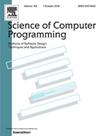Testing non-commutativity of reduce functions with multi-column inputs
IF 1.4
4区 计算机科学
Q3 COMPUTER SCIENCE, SOFTWARE ENGINEERING
引用次数: 0
Abstract
With the continuous development of the MapReduce programming model, it is necessary to ensure the reliability of MapReduce programs. In practice, the non-commutativity of Reduce functions seriously affects the reliability of the MapReduce program, which is difficult to debug and even causes errors. Current researches on the non-commutability detection of Reduce function consider the case that the input value is a single attribute. However, such researches ignore the situation where inputs to most reduce functions in practical applications consist of multiple columns (such as a table). To test the commutativity of reduce functions where each input record may contain several input attributes, a new testing method is proposed. This approach uses symbolic execution tools to help generate a few input records, and breaks their data dependencies to generate an original test case t0, with a dynamic program slicing technique to lessen the scale of t0. And the ultimate test suite is consisted of different permutations of records in t0. In the end, experiments demonstrate the effectiveness of our testing method and that the permutation method Gm is helpful to reduce its complexity.
测试多列输入约简函数的非交换性
随着MapReduce编程模型的不断发展,需要保证MapReduce程序的可靠性。在实际应用中,Reduce函数的非交换性严重影响了MapReduce程序的可靠性,难以调试,甚至会导致错误。目前关于Reduce函数不可交换性检测的研究都考虑了输入值为单个属性的情况。然而,这些研究忽略了实际应用中大多数reduce函数的输入是由多列(例如一个表)组成的情况。为了测试每条输入记录可能包含多个输入属性的约简函数的交换性,提出了一种新的测试方法。这种方法使用符号执行工具来帮助生成一些输入记录,并打破它们的数据依赖关系来生成原始测试用例t0,使用动态程序切片技术来减少t0的规模。最终的测试套件由不同排列的记录组成。最后,通过实验验证了该测试方法的有效性,并证明了置换法Gm有助于降低测试的复杂度。
本文章由计算机程序翻译,如有差异,请以英文原文为准。
求助全文
约1分钟内获得全文
求助全文
来源期刊

Science of Computer Programming
工程技术-计算机:软件工程
CiteScore
3.80
自引率
0.00%
发文量
76
审稿时长
67 days
期刊介绍:
Science of Computer Programming is dedicated to the distribution of research results in the areas of software systems development, use and maintenance, including the software aspects of hardware design.
The journal has a wide scope ranging from the many facets of methodological foundations to the details of technical issues andthe aspects of industrial practice.
The subjects of interest to SCP cover the entire spectrum of methods for the entire life cycle of software systems, including
• Requirements, specification, design, validation, verification, coding, testing, maintenance, metrics and renovation of software;
• Design, implementation and evaluation of programming languages;
• Programming environments, development tools, visualisation and animation;
• Management of the development process;
• Human factors in software, software for social interaction, software for social computing;
• Cyber physical systems, and software for the interaction between the physical and the machine;
• Software aspects of infrastructure services, system administration, and network management.
 求助内容:
求助内容: 应助结果提醒方式:
应助结果提醒方式:


